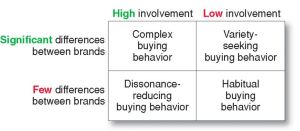Consumer Buying Behavior
Types of buying behavior
There are four different types of buying behavior based on the types of products that are intended to be purchased.
Stimulus-Response Model
The stimulus–response model is a characterization of a statistical unit (such as a neuron) as a black box model, predicting a quantitative response to a quantitative stimulus. In this model, marketing and other stimuli enter the customers “black box” and produce certain responses. Marketing management must try to work out what goes on the in the mind of the customer – the “black box”.
Marketing and other stimuli: A consumer is confronted with a stimulus in the environment. This stimulus could be of two kinds;
a) One that is presented by the marketer through the marketing mix or the 4Ps, product, price, place and promotion;
- product: attributes, features, appearance, packaging etc.
- price: cost, value, esteem (prestige)
- place: location and convenience, accessibility
- promotion: advertising, sales promotion, personal selling, publicity, direct marketing.
b) The other that is presented by the environment, and could be economic, technological, political and cultural.
Buyer’s black box: The stimulus that is presented to the consumer by the marketer and the environment is then dealt with by the buyer’s black box. The buyer’s black box comprises two sub components, viz., the buyer’s characteristics and the buyer decision process.
The Buyer’s characteristics influence how he or she perceives the stimuli; the decision-making process determines what buying behavior is undertaken.
The first stage of understanding buyer behavior is to focus on the factors that determine the “buyer characteristics” in the “black box”. These can be summarized as follows:
Customers go through a five-stage decision-making process in any purchase. This is summarized in the diagram below:
 This model is important for anyone making marketing decisions. It forces the marketer to consider the whole buying process rather than just the purchase decision (when it may be too late for a business to influence the choice!)
This model is important for anyone making marketing decisions. It forces the marketer to consider the whole buying process rather than just the purchase decision (when it may be too late for a business to influence the choice!)
The model implies that customers pass through all stages in every purchase. However, in more routine purchases, customers often skip or reverse some of the stages.
The buying process starts with need recognition. At this stage, the buyer recognizes a problem or need.
An “aroused” customer then needs to decide how much information (if any) is required. If the need is strong and there is a product or service that meets the need close to hand, then a purchase decision is likely to be made there and then. If not, then the process of information search begins.
A customer can obtain information from several sources:
• Personal sources: family, friends, neighbors etc
• Commercial sources: advertising; salespeople; retailers; dealers; packaging; point-of-sale displays
• Public sources: newspapers, radio, television, consumer organisations; specialist magazines
• Experiential sources: handling, examining, using the product
The usefulness and influence of these sources of information will vary by product and by customer.
In the evaluation stage, the customer must choose between the alternative brands, products and services. An important determinant of the extent of evaluation is whether the customer feels “involved” in the product. By involvement, we mean the degree of perceived relevance and personal importance that accompanies the choice.
The final stage is the post-purchase evaluation of the decision. It is common for customers to experience concerns after making a purchase decision. This arises from a concept that is known as “cognitive dissonance”. The customer, having bought a product, may feel that an alternative would have been preferable. In these circumstances that customer will not repurchase immediately, but is likely to switch brands next time.
To manage the post-purchase stage, it is the job of the marketing team to persuade the potential customer that the product will satisfy his or her needs. Then after having made a purchase, the customer should be encouraged that he or she has made the right decision.



